Cdx1 autoregulation is governed by a novel Cdx1-LEF1 transcription complex
- PMID: 15143193
- PMCID: PMC416402
- DOI: 10.1128/MCB.24.11.5028-5038.2004
Cdx1 autoregulation is governed by a novel Cdx1-LEF1 transcription complex
Abstract
The Cdx1 gene product is essential for normal anterior-posterior vertebral patterning. Expression of Cdx1 is regulated by several pathways implicated in anterior-posterior patterning events, including retinoid and Wnt signaling. We have previously shown that retinoic acid plays a key role in early stages of Cdx1 expression at embryonic day 7.5 (E7.5), while both Wnt3a signaling and an autoregulatory loop, dependent on Cdx1 itself, are involved in later stages of expression (E8.5 to E9.5). This autoregulation is reflected by the ability of Cdx1 to affect expression from proximal Cdx1 promoter sequences in tissue culture. However, this region is devoid of a demonstrable Cdx response element(s). We have now found that Cdx1 and LEF1, a nuclear effector of Wnt signaling, synergize to induce expression from the Cdx1 promoter through previously documented LEF/T-cell factor response elements. We also found a direct physical interaction between the homeodomain of Cdx1 and the B box of LEF1, suggesting a basis for this synergy. Consistent with these observations, analysis of Cdx1 Wnt3a(vt) compound mutants demonstrated that Wnt and Cdx1 converged on Cdx1 expression and vertebral patterning in vivo. Further data suggest that Cdx-high-mobility group box interactions might be involved in a number of additional pathways.
Figures
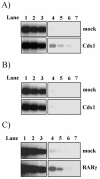

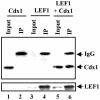
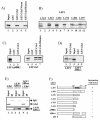

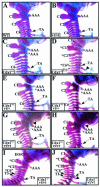

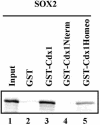
References
-
- Allan, D., M. Houle, N. Bouchard, B. I. Meyer, P. Gruss, and D. Lohnes. 2001. RAR gamma and Cdx1 interactions in vertebral patterning. Dev. Biol. 240:46-60. - PubMed
-
- Beck, F., T. Erler, A. Russell, and R. James. 1995. Expression of Cdx-2 in the mouse embryo and placenta: possible role in patterning of the extra-embryonic membranes. Dev. Dyn. 204:219-227. - PubMed
-
- Bel-Vialar, S., N. Itasaki, and R. Krumlauf. 2002. Initiating Hox gene expression: in the early chick neural tube differential sensitivity to FGF and RA signaling subdivides the HoxB genes in two distinct groups. Development 129:5103-5115. - PubMed
-
- Boras, K., and P. A. Hamel. 2002. Alx4 binding to LEF-1 regulates N-CAM promoter activity. J. Biol. Chem. 277:1120-1127. - PubMed
-
- Burke, A. C., C. E. Nelson, B. A. Morgan, and C. Tabin. 1995. Hox genes and the evolution of vertebrate axial morphology. Development 121:333-346. - PubMed
Publication types
MeSH terms
Substances
LinkOut - more resources
Full Text Sources
Molecular Biology Databases
